The Holiday Cookie Guide
Cookie Recipes and How I Store and Pack My Cookies
Hello Friends,
Many years ago (when I first started my blog), I naively participated in an online cookie exchange. The premise seemed simple; I’d bake my favorite cookies, pack, and ship them off. Here’s where I went wrong; I looked at the previous years’ cookie exchanges after signing up. I about died! Everyone’s cookies looked like they’d come straight out of a Martha Stewart or glossy food magazine. The sugar icing on the cookies was perfectly drawn out, the color scheme choices were like a Farrow and Ball catalog for cookies, and my professional experience as a cook at the time could be measured on a quarter of my thumb.
Terror quickly took over. I quickly learned that cookie exchanges could be competitive (even though they’re not supposed to be a contest). Doubts and questions crept in. How would I pack the cookies in a way that kept them fresh and undamaged (after all, they’re pieces of art in the creator’s mind), and would my cookie box look as nice as everyone else’s? What did I get myself into?
I had three weeks to prepare, which wasn’t enough time to practice. I knew it would be foolish to compete with the marvelous look of cutout cookies that were ornately decorated with brightly colored icings. Some of the participants already had custom packaging created for their cookies. I decided it might be best to go simple and skip the frosting design Olympics. I wished I could get out of the entire thing.
I opted for drop cookies. They’re simple and usually need no frosting; they need to look like circles. I could manage that. My next problem was a little more complicated. How to package and ship the cookies and ensure they still tasted fresh by the time they arrived in the recipient’s hands. This is where I failed miserably. I’d chosen paper boxes to pack the cookies and shipped them inside the standard mailbox cardboard containers. Two packages were damaged in the hustle and bustle of mailing. Against my better judgment, I packed the cookies in paper bags, and some of them turned stale, and others broke during shipping. After my big cookie debacle, I hid in shame for a few weeks, but the sun always rises the next day. Though I never participated in another cookie exchange, I learned how to pack my cookies and improve my frosting skills.
Cookie storage is a battle between nature and humankind; nature always wins. Our goal is to delay that win.
Hygroscopicity, Water Availability, and Oxidation of Fats
The ability to attract and absorb water from air is called hygroscopicity. If dry food absorbs too much moisture from the air, it will lose its crispiness, and the water in the food will also increase. If the conditions are hospitable, harmful spoilage microbes will start to colonize and destroy the food.
All cereal-based flours are hygroscopic by nature. They love absorbing water present in the air, begin to taste off, the fats turn rancid, and bacteria and fungi quickly show up. This is one reason why it is recommended to store flour in the freezer. Nut-based flours can also easily absorb moisture from the air. They also contain a lot of fat, and the fats oxidize and turn rancid.
Here are some general tips on baking and storing cookies.
Higher temperatures and longer baking times will make a cookie crispier, and lower baking temperatures and shorter baking times will create a cookie softer and chewier.
For a drier and crispier cookie, use the convection oven setting. Convection ovens use powerful fans to distribute hot air; this makes the cookie bake faster because it helps dry the cookie dough quickly. You will need to reduce the temperature by 25F/15C – so a 350F/180C baking temperature for a cookie needs to be reduced to 325F/165C when using the convection oven setting. The cooking time must also be reduced. Usually, a 25% reduction in time is a good place to start. Most ovens automatically adjust the temperature when switching between regular and convection settings. Another tip when using convection ovens, I prefer using rimless over rimmed baking sheets because that extra height at the edge acts like a dam preventing the hot air from circulating properly through the cookie dough on the sheet.
Crispier cookies can be achieved by increasing the amount of sugar.
Too much fat, like butter, will make the cookie spread during baking. Hence cutout cookies that need to retain their shape usually use a lower quantity of fat.
Chewier cookies can be made using a leavener like baking soda, baking powder, and eggs. All these ingredients help produce an airier texture in the cookie.
Watch for weights listed in a recipe– 1 cup of all-purpose flour weighs differently. For my recipes – I use 140 g, but if you compare weights by different media outlets, you will notice significant discrepancies: King Arthur Baking Company uses 120 g, and The New York Times uses 125 g. There are a couple of reasons for this. First, all cup measures aren’t created equally. I’ve got three sets of cup measurements from different companies that each produce different weights of flour. Make sure your cups actually measure what they say (an excellent way to test this is to weigh 1 cup of pure water, which should register at 250 g). Flour is a finely ground grain, which also packs quite a bit of air. If you take a cup, measure, and scoop a cup of flour out from a bag and level the top, it will weigh less than if you pack the flour down in the cup, fill it to the brim, and measure. In general, it’s safer to stick to weights. Cup measures also vary by country, making cup measures even more painful to work with.
Don’t use expired flours; they will leave a rancid taste in the cookies. Nut-based flours like almond and hazelnut and non-nut-based flours like coconut are the worst; they are richer in fat and go rancid quickly, leaving a foul smell and texture.
When storing cookies long-term, keep them locked away from moisture. Seal cookies in airtight bags like cellophane or coated bags and use silica gel bead bags (save the ones packed in dry food and reuse them) to protect them from humidity in the atmosphere.
I prefer to store cookies in metal tins and then pack them in cardboard shipping boxes. I also fill the space between the cookies and the metal tin with either crinkle-cut, newspaper, or starch-based popcorn fillers (BTW, don’t eat them, yeah, it’s starch, but it’s not edible grade).
This is obvious but bears mentioning. Select the appropriate shipping time based on the recipient’s address, the weather, and the cost. In warmer locations like Southern California, I avoid shipping frosted cookies, because there is a risk of the frosting melting from the heat if the box is left outside in the sun.
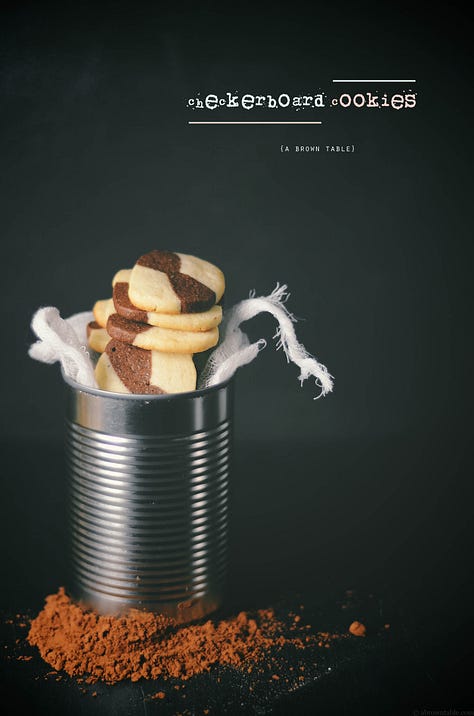
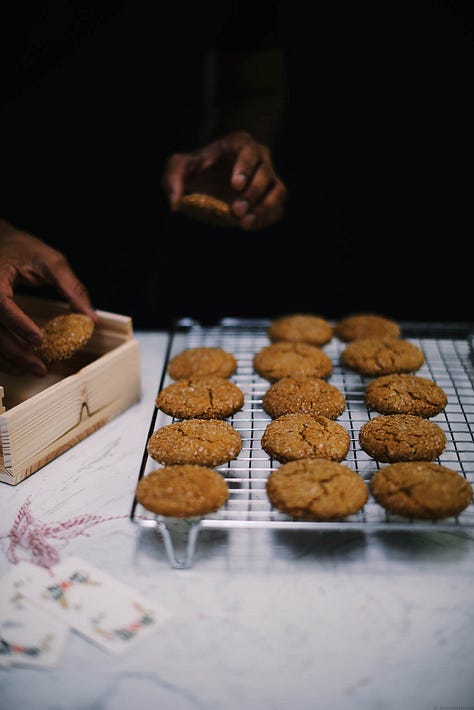

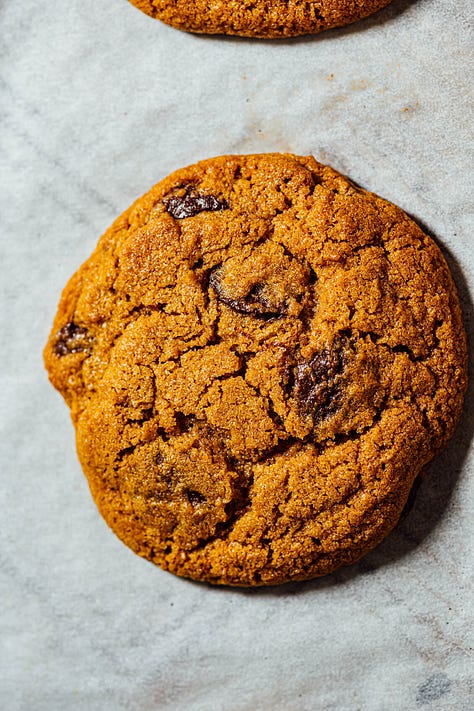
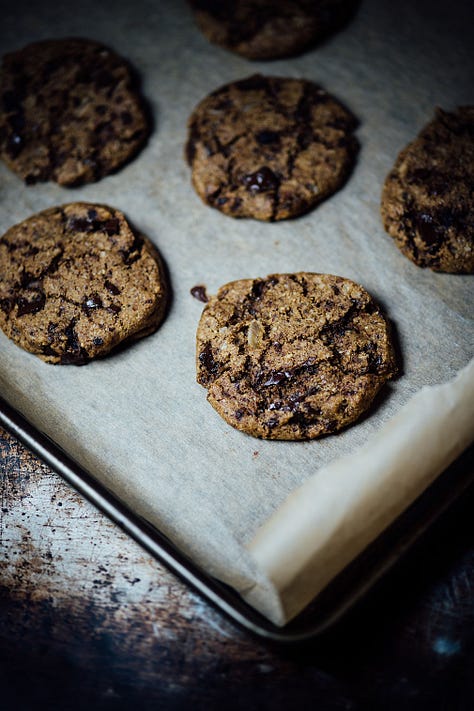
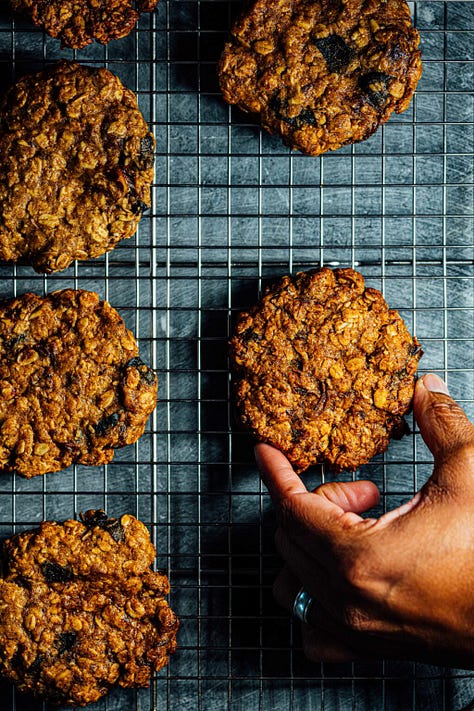
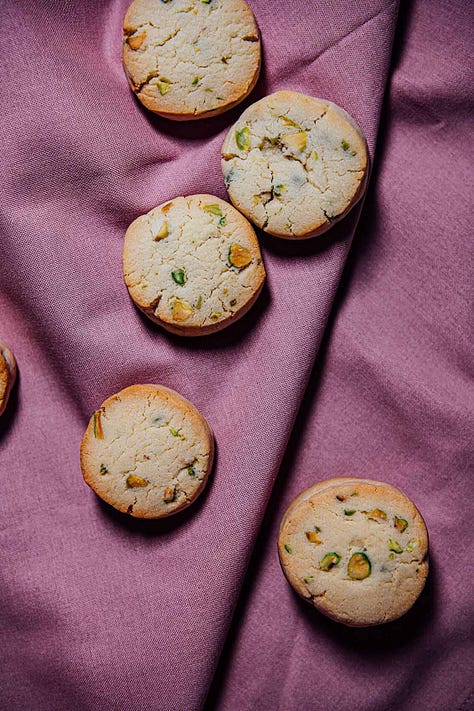
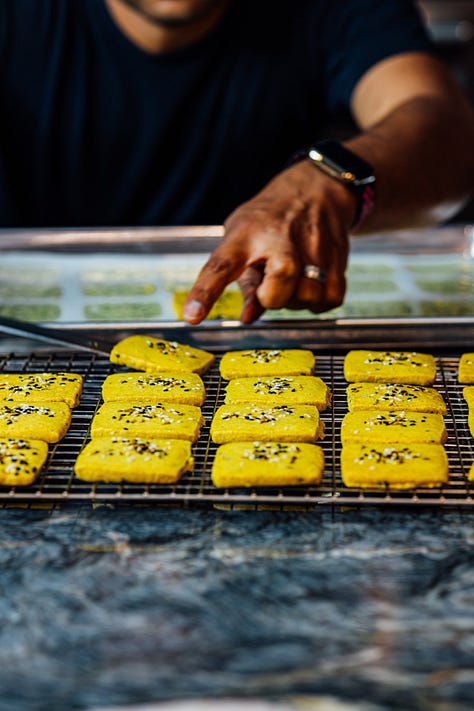
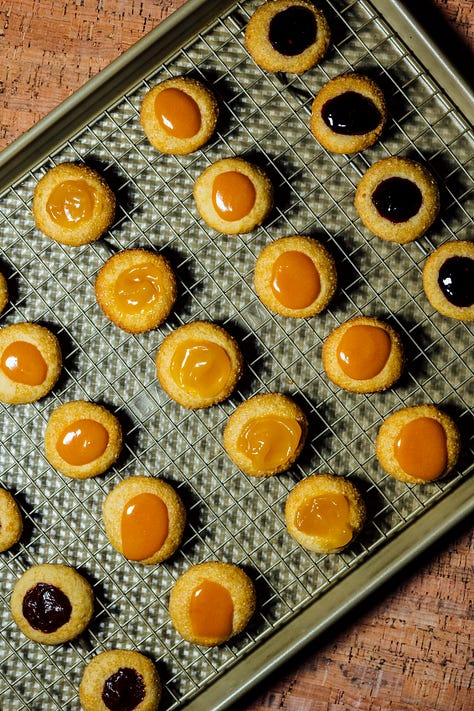
The Holiday Cookie Collection
The best part about thumbprint or jam drop cookies is how fun they’re to make and how unfussy the entire process is. No cookie cutters, just a thumb to make a well in the cookie dough. My policy on the choice of fillings, use whatever makes you the happiest.
These shortbread cookies are buttery and crisp, will melt in your mouth, and they’re inspired by the different spiced cookies baked and served in India during teatime. Turmeric gives them a burst of golden sunshinelike tint, while the addition of spices gives them an irresistible fragrance. I’ve also added sesame and fennel seeds for a little crunch and nutty flavor.
Chocolate chip cookies are one of those recipes, just like meatballs or mac and cheese; they’re highly personal, and we all have opinions on what characteristics make them special. I like my cookies to be crispy on the exterior and chewy in the center. Here’s my basic chocolate chip cookie recipe.
In the early eighteenth century, a marriage took place in Turin, Italy, and the world has never been quite the same. I’m talking about the sacred union of chocolate and hazelnuts, ground together into what is called gianduja. It was born out of economic necessity when cocoa was expensive, and hazelnuts became a filler. Be forewarned: these cookies are maddeningly good.
These gingersnap cookies get their spicy punch from three different gingers and black pepper forms, while the demerara sugar provides a sweet, crunchy texture to the cookie. Gingersnaps are best eaten with a cup of warm coffee or tea.
This is a chai-spiced version of my gingersnaps. There’s extra ginger, ground black tea leaves, and chai masala for the full effect, and they’re great with tea or coffee.
Caramelized dates and figs come together in these crispy, chewy, spiced oatmeal cookies. Eat them warm or cool but be warned, one cookie is never enough!
These delightful cookies are perfect with hot tea or coffee. In India, pistachios and milk are a common combination in many desserts like pedas (a type of milk fudge), and to play off that theme, I’ve created these cookies that use milk powder and bright green pistachios. The cookies aren’t completely soft; they’re crisp on the edges and tender in the center; combined with the texture of the baked pistachios, it feels much nicer on the palette. I’ve also got a special white chocolate-dipped version of these cookies in the holiday cookie edition at The Kitchn this year.
The whole-grain cookies are gluten-free and an excellent addition to your holiday cookie collection. The texture of these cookies is similar to shortbread with a sandy texture. I will caution you that the dough will stick to work with, so follow my instructions to roll them out between sheets of parchment paper and freeze them to peel the cutout cookies easily.
Checkerboard cookies are one of my favorite childhood cookies, and I love making them year-round, especially at Christmas. To increase the number of checks, double or triple the recipe to make more logs of the vanilla and cocoa dough and arrange them alternately to create the checked pattern.
Until next time,
xx
Nik
Disclaimer: There might be a couple of affiliate links in this newsletter, which means that I might get a small commission, at no extra cost to you, from every purchase you make via the link.



Marvellous
The best most valuable cookie info I have ever seen for us amateurs.